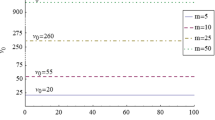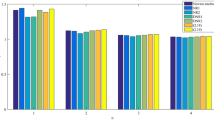Summary.
In this paper, we introduce the notion of hybrid procedures for solving a system of linear equations. A hybrid procedure consists in a combination of two arbitrary approximate solutions with coefficients summing up to one. Thus the combination only depends on one parameter whose value is chosen in order to minimize the Euclidean norm of the residual vector obtained by the hybrid procedure. Properties of such procedures are studied in detail. The two approximate solutions which are combined in a hybrid procedure are usually obtained by two iterative methods. Several strategies for combining these two methods together or with the previous iterate of the hybrid procedure itself are discussed and their properties are analyzed. Numerical experiments illustrate the various procedures.
Similar content being viewed by others
Author information
Authors and Affiliations
Additional information
Received October 21, 1992/Revised version received May 28, 1993
Rights and permissions
About this article
Cite this article
Brezinski, C., Redivo-Zaglia, M. Hybrid procedures for solving linear systems . Numer. Math. 67, 1–19 (1994). https://doi.org/10.1007/s002110050015
Issue Date:
DOI: https://doi.org/10.1007/s002110050015




